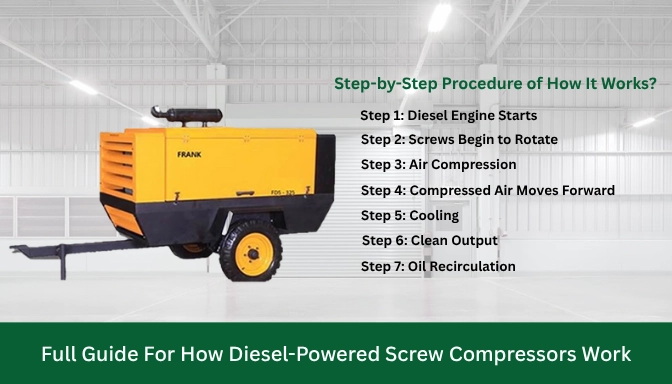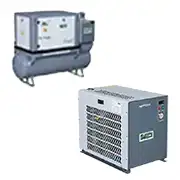Understanding The Working of Diesel-Powered Screw Compressor
Compressed air is essential in numerous industries. It powers machines, tools, and processes. This diesel-driven screw compressor is the great choice for any situation where electricity is not available or sufficient. These machines are easily movable and perfect for any place, such as construction and remote or rural areas. But how do they function? In this vlog, let's see the working principle of diesel-driven screw compressors clearly and simply.

What is a diesel-powered screw compressor?
A diesel-powered screw compressor is an air compressor that functions in a diesel engine instead of an electric motor to set off turning screws. These screws compress air by decreasing its volume, making for energizing tools or equipment. This type of compressor is suitable for outdoor areas, mining operations, road projects, and places without electricity.
Essential Parts of a Diesel Screw Compressor
It is useful to understand how it works. Let's look at the main components of the diesel screw compressor.
Diesel Engine
- Acts as the primary power source.
- Replaces electric motors used in standard compressors.
- Provides energy to turn the screws.
Air End (Screw Assembly)
- It has two helical (spiral) screws, one male and one female.
- These screws rotate to trap and compress air.
Cooling System
- This system keeps the compressor from overheating.
- Includes radiators and fans, similar to a car engine.
Air Filter
- It cleans incoming air before compression.
- It prevents dust and dirt from damaging the machine.
Oil Separator and Filter
- It separates oil from compressed air.
- It keeps both air and oil clean.
Fuel Tank
- It stores diesel fuel.
- It powers the engine for long working hours.
Control Panel
- It allows users to start, stop, and monitor the compressor.
- It shows fuel level, air pressure, engine temperature, and more.
Step-by-Step Procedure of How It Works?
Now let's discuss how a diesel-powered screw compressor works:
Step 1: Diesel Engine Starts
The process begins when you start the engine. The diesel engine uses fuel from the tank and starts running. This engine is connected to the screw assembly through a coupling or gearbox.
Step 2: Screws Begin to Rotate
As the engine starts, it shifts the two screws inside the air end. These screws spin in opposite directions. As they rotate, air enters from one end of the compressor.
Step 3: Air Compression
The rotating screws entrap air between their threads. As the screws turn, the space between the threads gets smaller, compressing the air. This is called positive displacement. It compresses the air into a smaller space, which increases the pressure.
Step 4: Compressed Air Moves Forward
After compression, the air flows into a separate tank. This tank separates the oil from the air in most oil-injected compressors, removing most of the oil content.
Step 5: Cooling
The engine and the air get hot when the air is compressed. It has a cooling system, often a fan and radiator, to control the engine's temperature and compressed air.
Step 6: Clean Output
The final air passes through a fine separator filter to remove any remaining oil particles. The clean, pressurized air is then sent to tools or storage tanks.
Step 7: Oil Recirculation
The oil used in compression is not wasted. After separation, the oil is filtered and returned to the compressor for reuse.
Why Use a Diesel-Powered Compressor?
Mobility
They can move effortlessly to work locations and have no necessity for a power line.
Strong Performance
Diesel engines possess great strength. They are capable of running for hours in challenging conditions.
Affordable in Remote Areas
A diesel compressor removes the expense of installing power systems in areas lacking electricity.
Long-lasting & Dependable
These machines are designed for outdoor work and demanding applications. With proper maintenance, they last for years.
Maintenance Tips for Longevity
It is essential to maintain your compressor properly. Here are a few easy suggestions:
- Check the oil levels for both the engine and compressor every day to ensure proper lubrication and prevent damage.
- Regularly check the air filters and clean them when needed to maintain efficient airflow and protect the compressor from dust.
- Remove any moisture from the tank if present; it can lead to rust, reduce air quality, and damage internal parts.
- Regularly checking the fuel level and ensuring the compressor does not run without fuel could result in engine failure.
- Follow the recommended service schedule for oil changes, replace the filter, and check the belt; the compressor runs reliably and efficiently.
- Clean the radiators regularly to avoid overheating, especially when working in dusty or hot conditions.
Safety Considerations
Always follow safety steps when operating diesel-powered compressors:
- Never refuel while running — fire hazard.
- Ensure proper ventilation — diesel engines release fumes.
- Use hearing protection — compressors can be loud.
- Avoid overloading — use within rated air pressure.
- Check for leaks — especially in hoses and oil lines.
Choosing The Right Diesel Screw Compressor For Industrial Use
Diesel-powered screw compressors are essential machines for industrial use, especially when electricity is not available or sufficient. Their rotary screw technology guarantees gradual airflow, and the diesel engine gives freedom from the electric grid.
This guide helps you understand the working of diesel screw compressors so you can operate and maintain them effectively. You can use them better to retain and follow the proper safety procedures. Whether you work in construction, mining, or manufacturing, a diesel screw compressor can be your flexible partner to operations anywhere and anytime. Looking for reliable diesel-powered screw compressors? Contact Frank Compressor for top-quality solutions, including oil-free screw and piston compressors. We provide types of industrial air compressors, including oil-free screw air compressors, oil-free piston air screw compressors, and more in Coimbatore.
Recent Blogs
-
Single vs Two-Stage Reciprocating Air Compressor Overview
-
Top 10 Air Compressor Manufacturers in Coimbatore
-
Air Compressors for Electronics & Semiconductor Industry
-
Smart Air Compressors with IIoT & Remote Monitoring
-
Understanding Oil-Free Scroll Air Compressors & Advantages
-
Oil-Free vs Oil-Injected Compressors for Textile Industry
-
The Role of Medical Air Compressors in Modern Healthcare
-
Tips to Pick The Best High-Pressure Compressor For Business
-
Key Things to Check Before Installing a PET Air Compressor
-
Full Guide For How Diesel-Powered Screw Compressors Work
-
Benefits of Dual-Stage and Single-Stage Air Compressors
-
How to Silence an Air Compressor for a Peaceful Workspace?
-
Expert Tips to Select Screw Air Compressor For Packaging
-
Benefits of Oil-Free Air Compressors For Food & Beverage Safety
-
The Importance of Refrigeration Air Dryers in Pharma Production
-
Why Choose a Permanent Magnetic Energy Saving Compressor
-
Industrial Diesel-Driven Screw Compressors For Remote Locations
-
The Importance of Air Compressors in Laser Cutting Machines
-
How Dental Air Compressors Benefit the Medical Sector
-
Key Applications and Benefits of Piston Vacuum Pumps in Industry
-
Understanding The Role of Air Dryers in Compressed Air System
-
Why Choose Rotary Screw Air Compressors: Essential Advantages
-
Innovative Design Features of Screw Compressors with VFD
-
Which One to Choose: Piston Vacuum Pumps vs Rotary Vane Vacuum Pumps?
-
A Step By Step Guide For Air Compressor Installation & Setup
-
Tips For Improve Your Compressor Life Span
-
Different Types Of Compressors And Their Uses In Industries
-
High-Pressure Air Compressors: Uses and Advantages for Industrial Solutions
-
How Air Compressors Are Transforming The Textile Industry ?
-
Tips For Prolonging Your Air Compressor’s Lifespan






























